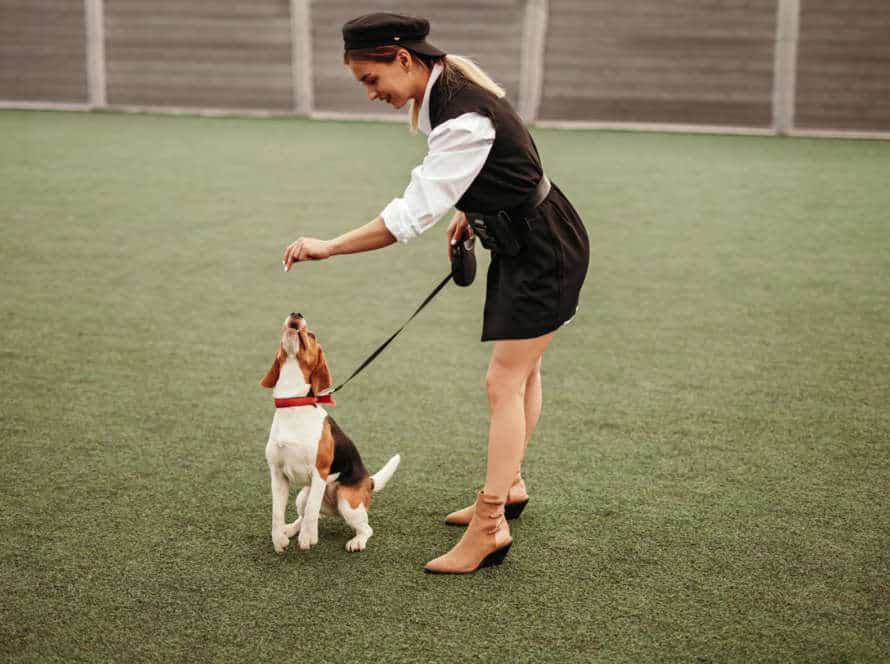Loose Leash Walking vs. Heeling: Which is Right for Your Dog?
Loose leash walking and heeling are two must-know training skills for any well-trained pup. But, which one is right for your furry friend? That depends on your lifestyle, training goals and pup’s personality.
Loose leash walking: This involves your pup walking beside you with a loose leash. They are free to sniff and explore their surroundings. Ideal for easily distracted or high energy pups, and owners who like leisurely walks.
Heeling: This method involves your pup walking at your side with a short leash. They stay focused on you. Perfect for owners who need their pup to stay close, like during competitions or in crowded areas.
In the end, it all comes down to your needs and pup’s personality. So, consider both when choosing a technique.
Understanding Loose Leash Walking
Loose leash walking is fab! It helps your pup learn to calmly and politely stroll with you on the lead. Teaching them to stay near you, with a bit of slack – so they can sniff around and explore – is key. What else is there to know? Let’s have a peek!
Definition and purpose of Loose Leash Walking
Loose Leash Walking is a way to train your dog to calmly and comfortably walk on a leash. Not like heeling, which requires a more formal walking style with the pup close by your side. Loose Leash Walking is great for taking your pup to the park, hiking trails or everyday errands.
To teach your pup, use positive reinforcement like treats, praise and toys as rewards. Take your pup on longer and longer walks while monitoring their behavior – this will make the walk enjoyable and safe.
Pro Tip: Practice Loose Leash Walking every day. With patience and consistency, your pup will learn to walk without any help.
Benefits of training your dog for Loose Leash Walking
Training your pup for loose leash walking has many advantages, such as better behavior, better exercise, and improved connection with your four-legged friend.
Here are some of the advantages:
- Better conduct: Loose leash walking helps teach your pooch to focus on walking calmly next to you. This can lead to an overall improvement in their behavior and attentiveness.
- Exercise: Walking your doggy is a great way to keep you and them healthy. Loose leash walking makes those walks more enjoyable and beneficial for everyone.
- Bonding: Training your canine to walk on a loose leash is a great bonding experience. It requires patience, attention, and communication between you and your pup.
Note: Loose leash walking is different from heeling. Heeling needs your pooch to walk directly beside you in a structured and focused manner. Loose leash walking allows more freedom and flexibility, making it a great choice for casual walks.
Common training techniques for Loose Leash Walking
Loose Leash Walking and Heeling are two different leashing techniques. It depends on your preferences and goals when choosing one.
Heeling involves walking your pup close by your left side, with his head aligned with your leg. It’s an advanced technique and requires training, making it great for dogs with a lot of energy.
Loose Leash Walking gives the dog some freedom to move and sniff. It can be trained with positive reinforcement, treats, and praise. Thus, it’s perfect for puppies and dogs new to leash-walking.
Common techniques for Loose Leash Walking involve:
- Rewarding the pup when the leash is loose
- Stopping when they pull
- Using verbal cues
- Offering positive reinforcement with treats and praise
Understanding Heeling
Heeling is a crucial part of a pup’s training. Not just for show dogs! It teaches the dog to close by your side, stay alert and focused on you. Plus, it gives them mental and physical stimulation. Let’s look at the fundamentals of heeling and compare it to loose leash walking.
Definition and purpose of Heeling
Heeling is a special dog training technique. The pup should walk next to its handler, head up, shoulders back, eyes on the handler. Heeling teaches a dog to stay obedient and calm, without pulling on the leash or getting distracted.
It is different than loose leash walking, which has more slack in the leash and doesn’t need as much obedience. Heeling is best for doggos with lots of energy, prey drives, or those trained for shows/competitions. Loose leash walking is for all types of dogs and makes for a relaxed walk.
Pro tip: Be consistent with training and reward good behavior with treats or words of praise. Practice every day!
Benefits of training your dog for Heeling
Heeling is a training technique that teaches dogs to walk close to the owner’s side, without pulling the leash or running around. Here are the advantages of training your dog for heeling:
- Better control: Heeling allows owners to have more control over their dog’s movements, making it easier to travel through busy places, cross streets, and avoid potential danger.
- Bonding: Heeling training makes the bond between the owner and the dog stronger by establishing a clear communication system and trust.
- Exercise: Heeling requires focus and muscles to be controlled, making it a great exercise, both mentally and physically, for both the dog and the owner.
- Positive behavior: Heeling teaches the dog positive behavior, impulse control, and lessens unwanted behaviors such as jumping, pulling, and barking.
Pro Tip: Start heeling training in a quiet, distraction-free area, and increase distractions slowly as the dog advances. Reward good behavior with treats or compliments to reinforce it.
Common training techniques for Heeling
Heeling is key when it comes to dog training. Try these techniques to teach your pup:
- Loose Leash Walking- Keep the leash slack and reward your pup for staying close. They’ll learn to adjust their walking speed to yours.
- Luring- Use treats or toys to lure your pup into the correct position. They’ll connect the heel position with a reward.
- Clicker Training- Mark desired behavior with a clicker and give a reward. Your pup will learn to heel with this method.
- Leash Corrections- Gently pull the leash and release when your pup adjusts.
What works for one pup won’t for another, so choose the technique that suits them best. Pro Tip: Patience and consistency are essential for success! With the right attitude, your pup can be an expert heel walker in no time.
Factors to Consider when Choosing Between Loose Leash Walking and Heeling
Deciding which leash walking style is suitable for your pup can be tough. Several things should be taken into account, like your dog’s breed, age, personality and what they’ll be doing whilst on the leash. Let’s examine the advantages and disadvantages of both methods, so you can pick the most suitable one for your doggy.
Your dog’s breed, age, and physical abilities
When choosing between loose leash walking and heeling for your dog, there are some things to think of. Breed, age, and physical abilities of your pup are key.
Retrievers and shepherds may enjoy heeling because of their herding instincts. Whereas, smaller breeds and older dogs may like loose leash walking more due to its gentleness.
Also, think about your doggo’s physical abilities. If they have trouble with mobility, loose leash walking is more suitable. On the contrary, if they have lots of energy and pull on the leash, heeling may be a better choice to help them focus and learn good walking habits.
Finally, the decision is up to you, considering your pup’s characteristics and your preferences as a handler.
Your lifestyle and activity level
What’s the best way to walk your dog? Loose leash walking or heeling? It all depends on your lifestyle and your pup’s activity level.
Loose leash walking: Perfect for owners who love leisurely strolls and dogs that are less active or don’t need intense training. Letting your pooch have some freedom while still keeping them under control.
Heeling: If you prefer a more structured and formal experience, this might be the way to go. Great for dogs with higher energy who need more advanced training. Plus, it’s useful for activities like hunting and agility!
In the end, it’s all about what’s best for you and your pup.
Your goals for training and obedience
Training and obedience for your pup is key. Understand what you want to do to decide between loose leash walking and heeling.
- Loose Leash Walking: Let your dog explore while still being in control. Perfect for casual walks and freedom.
- Heeling: Dog should be by your side, no sniffing or straying. This is seen in competitions and provides more control.
Consider these factors: Purpose of training, breed and personality of dog, owner’s preference and lifestyle.
Pro Tip: Combine the two for a well-rounded training.
Training Tips and Techniques
Training your pup is a must for an obedient and well-mannered dog. When it comes to walking your pup, there are diverse techniques. Loose Leash Walking and Heeling are two of them. Let’s explore the pros and cons of each approach. That way, you can select the best one for your doggo!
Positive reinforcement training methods
Positive reinforcement training is a great way to teach dogs good behaviors, without punishing them. It works by rewarding good behavior with treats, praise, and affection. These tips can help you train your dog to have loose leash walking and heeling:
Loose Leash Walking:
- Give treats and praise when your pup walks calmly on a loose leash.
- If they pull or lunge, stop and turn around. Wait until they’re calm before continuing.
- Use a front-clip harness to stop pulling and to guide them back to you.
Heeling:
- Give treats and praise when your pup walks at your side on a loose leash.
- Use a cue word or clicker to signal when they do it correctly.
- Gradually increase the time they can maintain heeling. Use treats and praise to motivate them.
Positive reinforcement takes patience and consistency. But it can lead to a strong bond and a well-trained dog.
Common training tools for Loose Leash Walking and Heeling
When it comes to training dogs to walk on a leash, there are several tools trainers use. Common ones are front-clip harnesses, head halters, and flat collars with a traditional leash.
Front-clip harnesses redirect the dog’s attention to their owners. Head halters provide more control over larger or stronger dogs. Flat collars are basic but can still be effective.
Pro Tip: Consistency and patience are essential. Reward good behavior and avoid punishment or physical corrections.
Troubleshooting common training challenges
Training a dog can be tough. Here are some common issues with their solutions for Loose Leash Walking and Heeling.
For Loose Leash Walking:
- Challenge: Pulling.
- Challenge: Sniffing too much.
- Challenge: Distractions.
Solution: Stop when your dog pulls. Get its attention.
Solution: Teach a cue when sniffing is allowed.
Solution: Increase distance from distractions or move to a quieter spot.
For Heeling:
- Challenge: Forgetting.
- Challenge: Not sustaining.
- Challenge: Disobedience.
Solution: Use a visual cue. Reward for the right position.
Solution: Practice walking for longer. Gradually increase distance and duration.
Solution: Check training methods. Give clear, consistent commands.
Conclusion: Choosing the Right Training Method for Your Dog
Finishing up, the selection between loose leash walking and heeling is based on your pooch’s temperament, action issues, and the training aims you have.
- Loose Leash Walking: This approach is great for dogs who usually pull on the lead or get easily sidetracked. It concentrates on educating your pup to amble quietly by your side while keeping the leash slack.
- Heeling: This method is more complex and necessitates your pup to stay near you at all times while walking. It is perfect for owners who want to train their dogs for obedience contests or dogs who require to remain concentrated on their handlers.
When selecting a training practice, bear in mind to be tolerant, consistent, and reward your pup for good conduct. With the accurate strategies and positive support, you can help your pup become a well-mannered and obedient companion.
Frequently Asked Questions
1. What is the difference between loose leash walking and heeling?
Loose leash walking allows some slack in the leash and lets the dog move freely within a certain distance, while heeling is a stricter walking position where the dog stays beside the handler’s leg.
2. Which one is better for my dog?
It depends on your dog’s personality and your own preference. If you want a more casual and comfortable walk, loose leash walking may be the better choice, but if you want more control over your dog’s movements, heeling may be a better option.
3. How do I train my dog for loose leash walking?
Start by teaching your dog basic obedience commands and then introduce them to walking on a leash. Reward your dog for staying close to you and gradually allow them more freedom, while consistently reinforcing good behavior.
4. Can any dog learn to heel?
Most dogs are capable of learning to heel with proper training and patience, but some breeds may find it more difficult due to their natural instincts or energy levels.
5. Is it okay to switch between loose leash walking and heeling?
Yes, it is perfectly fine to mix up your walking styles depending on the situation. Just make sure to communicate clearly with your dog and reinforce the correct behavior.
6. What if my dog pulls on the leash during walks?
If your dog pulls on the leash, it can be helpful to stop walking and wait for them to relax before continuing. You can also use positive reinforcement techniques to encourage your dog to walk calmly beside you.







